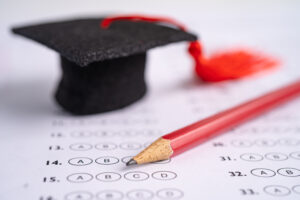High schools are incredibly important in shaping a student’s future. Indeed, the quality of the education a student receives in high school is the single most important factor in college admissions. This leads to a great deal of pressure for parents, who wonder where their child should go to school, and how to ensure they’ll succeed once they’re there.
In this article, we’ll go over the key steps to finding, vetting, and enrolling in a high school in Houston (though the process is similar elsewhere). We hope that by better understanding what the process entails, you are more prepared to face it, and feel less stress. Let’s get started and cover how to choose a high school for your child.
School Zoning and School Choice
Houston uses zoning to determine where most students attend schools; you simply attend whichever school your house is zoned to. This means where you live has the biggest impact on the quality of your child’s education.
There are options to attend other schools, however, using Houston’s school choice program. This allows students to apply to attend other schools within the Houston Independent School District (HISD). This is also how students apply to attend magnet schools within the district. This is a good option if you are not satisfied with the quality of your local schools.
School choice is incredibly competitive, especially for spots at the best schools. If there are more applicants than there are spaces, a lottery is used to determine who gets in. Once you have enrolled at a new school, you need to maintain your academic standing; if you do you will automatically carry over in the program, if not you will have to return to your zoned school.
Applications for school choice begin in September of the previous year. All applications that are submitted before the deadline are considered together, the only advantage in applying early is peace of mind (which is not to be discounted). The easiest and fastest way to apply is online.
What Makes a High School Good?
School choice will let you apply to “good” schools, but how should you determine which schools are good in the first place? We suggest you look for the following, and will explain why each matter:
- Student to teacher ratio, or average class size. The larger a class is, the less individual attention each student gets from their teachers, and the more difficult it is to stand out.
- Standardized test scores. While these do not measure intelligence, they are meant to measure how well a school has prepared students for college. While their efficacy is debated, they do provide a useful metric to evaluate high schools.
- Prior successes. A good high school will have most of its students graduate and attend college. High schools often boast of this information on their website. A school that has most of its students graduate on time and immediately enroll in college is doing a good job of preparing its students to succeed.
- Opportunities. A school is not academics alone, but the clubs, sports, organizations, and all other extracurricular opportunities it offers to its students. Schools with a thriving arts program, competitive academic teams, or other unique opportunities (such as an IB curriculum), are generally viewed as better, and are better able to serve students’ needs.
Other factors may matter to you, such as a strong music program, school location, or availability of AP or IB courses. It may take some research to determine which schools are best suited for your children. We have an article about the best high schools in Houston, to give you a place to start looking.
Public vs Private High Schools
We have thus far focused on public high schools. Private high schools are an option as well, though are not right for all students. While some private high schools do provide a great education, many others do not; just as with public schools, there is a wide variety in quality.
The price of private schools can be off-putting for some parents, and you should know that you can get an education of equal quality from public schools. There are other reasons to choose to attend a private school, such as religious or cultural values; these are unique to you, and you should make whatever choices are right for your situation. You should be aware that the cost of private school is often unrelated to the quality of the education it provides.
A final consideration is the Texas automatic admissions policy for UT Austin. Students in the top 6% of their class at a public high school are automatically granted admission to UT Austin. This is not the case for students at private high schools.

Choosing High School Courses
Part of enrolling in a high school is choosing your courses. There are requirements, but there is flexibility within them. The exact requirements and process depend on whether you are in a public or private school, but generally, you request courses online, and later receive a schedule from your school’s counselor. Depending on how popular the courses you requested are, and how many sections there are, you may or may not get your desired schedule. The first few days of school often involve a flurry of shifting schedules as all students try to get into the courses they want.
When selecting the courses you enroll in, you should be looking for the most challenging courses you can succeed in. Colleges want to see that you have challenged yourself academically, rather than merely skating by in easy courses.
There are various tracks of coursework in high schools, which cater to students of differing needs and abilities. At the top is the Honors/AP/IB track. The purpose of this track is to prepare students for college with a series of rigorous academic courses. Students in this track will take multiple advanced courses. Top-tier colleges will generally only admit students on this track.
In the middle is the track for average students. Depending on the school, these students may still take a few AP classes, but fewer of them at a time, and with more preparation.
Finally, there is the track for students who struggle academically. The courses here are focused on helping the students graduate. Some schools also offer courses to help students prepare to enter the trades, including shop or culinary classes. There is no shame in taking these classes, and a career in the trades can be quite rewarding. Most of the parents we work with, however, want to see their students land in the top track.
AP vs IB Courses
We’ve covered both Advanced Placement (AP), and International Baccalaureate (IB) courses before, but we’ll give you a quick rundown here. Both of these programs seek to give high school students a taste of advanced coursework and prepare them for the rigors of collegiate study.
AP courses are offered and taken individually, and you can take as many or as few as fit into your schedule. Each teacher must be certified with their particular course; while no two are exactly the same, each is held to the same standard. AP exams are given in the spring, and scoring high enough can count for college credit. It is possible to take AP classes without taking the exam or to take the exam without taking the class, but these are uncommon.
A score of 3 is required to pass an AP exam. A score of 3 to 5 will grant college credit, depending on the school and the test. We cover each school’s AP policy in our university guides.
IB is offered as a full curriculum and must be taken in full. The most common version lasts for junior and senior years and culminates in examinations. You cannot take these tests without having taken the full IB curriculum. A school is certified to teach an IB curriculum, with teachers within the school receiving further certification. Colleges will often give credit for IB scores over 6, but this again varies by course and college.
Both AP and IB courses prepare students for college, are looked upon favorably, and can grant college credit. One is not necessarily better than the other, but one may be better suited to a student’s strengths. AP classes are far more common however; if you want an IB curriculum you will need to actively seek it out, while many more schools have AP class options.
Final Thoughts
The transition from middle to high school is difficult, and a stressful time. Students have to deal with new routines, harder classes, and increased expectations, while parents already see college looming, and worry about the future. We hope this guide will help ease your transition and has answered any questions you may have.
Of course, we can’t cover everything in this article; if you would like further help or guidance during your high school transition, or dealing with the increased academic pressures of high school, schedule a free consultation to hear how we can help you. Our Candidacy Building service helps students find and explore their passions, while our Academic Coaching service allows them to live up to their full academic potential.








